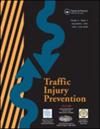Characterizing caregiver attitudes to optimize pediatric vehicular heatstroke campaigns
IF 1.9
3区 工程技术
Q3 PUBLIC, ENVIRONMENTAL & OCCUPATIONAL HEALTH
引用次数: 0
Abstract
Objective
Since 1998; approximately 1,000 US children have died due to pediatric vehicular heatstroke (PVH; i.e., children overheating in vehicles). As the frequency of cases have largely remained unchanged over time, there is a need for novel research that can inform effective PVH prevention efforts, such as awareness campaigns. The objective of this project was to characterize caregivers’ opinions about existing PVH campaigns and thoughts about what future campaigns should look like.
Methods
We conducted 4 virtual focus groups (16 participants total). Groups discussed broad childhood injury topics, as well as PVH. Groups also viewed existing communication campaigns for a variety of injury topics and provided their perspectives on what future campaigns focused on PVH should contain. All focus groups were recorded, transcribed, and de-identified. Two independent coders reviewed and coded transcripts, which were developed and applied using a directed-content approach. We then created code summaries, which were used to develop themes.
Results
Themes were: (1) PVH differs from other injuries, (2) Campaigns should be short, educational, practical, and include diverse populations/subjects, and (3) Campaigns should be placed where caregivers are with their children. Caregivers acknowledged they were misinformed about their PVH risk; providing them with real-world statistics changed their views about if they should adopt preventative actions. Participants voiced communicating this risk to caregivers with actions they can take to reduce their risk in future campaigns is important to promote widespread adoption of preventative measures.
Conclusions
Based on results, we recommend future campaigns consider the IDEA framework when developing novel PVH campaigns.
了解护理人员的态度,优化儿科车辆中暑宣传活动。
目的:自 1998 年以来,大约有 1000 名美国儿童死于小儿车辆中暑(PVH,即儿童在车内过热)。随着时间的推移,病例发生的频率基本保持不变,因此需要进行新的研究,为有效预防中暑(如开展宣传活动)提供依据。本项目旨在了解护理人员对现有预防 PVH 宣传活动的看法以及对未来宣传活动的想法:我们开展了 4 个虚拟焦点小组(共 16 人参加)。各小组讨论了广泛的儿童伤害话题以及自闭症儿童保健问题。各小组还观看了针对各种伤害主题的现有宣传活动,并就未来针对 PVH 的宣传活动应包含哪些内容发表了看法。所有焦点小组都进行了录音、转录和去标识。两名独立的编码员对记录誊本进行了审阅和编码,这些誊本是采用定向内容法编写和应用的。然后,我们创建了代码摘要,并将其用于制定主题:主题为(1) PVH 不同于其他伤害;(2) 宣传活动应简短、有教育意义、实用,并包括不同的人群/主题;(3) 宣传活动应在照顾者与孩子在一起的地方进行。护理人员承认,他们对自己的 PVH 风险存在误解;向他们提供真实世界的统计数据改变了他们对是否应采取预防措施的看法。参与者表示,在未来的宣传活动中,向照顾者传达这种风险以及他们可以采取的降低风险的行动对于促进预防措施的广泛采用非常重要:根据研究结果,我们建议未来的宣传活动在开发新的 PVH 宣传活动时考虑 IDEA 框架。
本文章由计算机程序翻译,如有差异,请以英文原文为准。
求助全文
约1分钟内获得全文
求助全文
来源期刊

Traffic Injury Prevention
PUBLIC, ENVIRONMENTAL & OCCUPATIONAL HEALTH-
CiteScore
3.60
自引率
10.00%
发文量
137
审稿时长
3 months
期刊介绍:
The purpose of Traffic Injury Prevention is to bridge the disciplines of medicine, engineering, public health and traffic safety in order to foster the science of traffic injury prevention. The archival journal focuses on research, interventions and evaluations within the areas of traffic safety, crash causation, injury prevention and treatment.
General topics within the journal''s scope are driver behavior, road infrastructure, emerging crash avoidance technologies, crash and injury epidemiology, alcohol and drugs, impact injury biomechanics, vehicle crashworthiness, occupant restraints, pedestrian safety, evaluation of interventions, economic consequences and emergency and clinical care with specific application to traffic injury prevention. The journal includes full length papers, review articles, case studies, brief technical notes and commentaries.
 求助内容:
求助内容: 应助结果提醒方式:
应助结果提醒方式:


